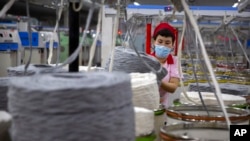Vietnam was the top exporter to the United States of products covered by the Uyghur Forced Labor Prevention Act in 2023, the first time a country has outranked China since the law passed in 2021, according to U.S. Customs and Border Protection.
The act bans the import of products made with Uyghur forced labor. It is a U.S. response to human rights abuses by Beijing of Uyghur and other Muslim minority groups in the Xinjiang Uyghur Autonomous Region in China.
Customs and Border Protection enforcement statistics released Jan. 26 show that Vietnam last year exported the greatest value of products that were denied entry to the U.S. since the law has been enforced, followed by Malaysia.
According to the data, in 2023 Vietnam accounted for the highest shipment value for the apparel, footwear and textiles sector at $19.14 million, with $10.22 million denied, followed by China at $17.70 million, of which $1.29 million were denied.
The Vietnam Ministry of Trade and Industry and the Ministry of Foreign Affairs did not respond to a request for comment on the report. China denies U.S. charges that include mass detentions of Uyghurs in re-education camps and the use of forced labor in manufacturing and agriculture sectors.
“This report presents the very intriguing development that goods made with forced labor in Xinjiang are increasingly being diverted to Vietnam for re-shipment to the US,” Phil Robertson, deputy director of the Asia division of Human Rights Watch, told VOA Vietnamese by email.
While U.S. business and political leaders talk about de-risking supply chains by moving them out of China, “it’s clearly not that simple,” Robertson said in the email. “These diversions are simply unacceptable, and the US needs to use its newly upgraded bilateral relationship with Vietnam to press leaders in Hanoi to halt these tainted goods from being shipped out of their ports to the US. The integrity of UFLPA enforcement depends on taking urgent action now against their transshipments.”
The U.S. and Vietnam upgraded their relations in September to a “comprehensive strategic partnership.”
The Department of Homeland Security’s Forced Labor Enforcement Task Force includes 30 items, from clothing to solar-grade polysilicon, in its product watch list, according to the Federal Register in December 2023.
Rushan Abbas, founder and executive director of the Campaign for Uyghurs in Herndon, Virginia, told VOA Vietnamese via email that China has increased exports from East Turkistan to neighboring countries and used this tactic to obfuscate the real origins of its products. East Turkistan is the Uyghur name for the area China calls the Xinjiang Uyghur Autonomous Region.
“Vietnam is one of these countries that China abuses to cover for its crimes,” Abbas added.
U.S. Customs officials did not respond to questions from VOA Vietnamese about how they selected incoming shipments for analysis.
CBP Assistant Port Director Ed Fox told the CNBC cable news network, “It’s a combination of intelligence, information that’s gathered from a variety of sources, all feeding into our expert cargo targeting systems.”
For clothing that includes cotton, one of Vietnam’s largest exports, U.S. officials use isotopic testing, which can link cotton to specific geographic origins, experts say.
The process is not yet a routine process for U.S. Customs, Eric Choy, the agency’s executive director for trade remedy and law enforcement, told Reuters in June. He added that officials at individual U.S. ports can request testing if they receive allegations about specific shipments or suspect the goods have links to Xinjiang.
According to Statista, Vietnam was among the five biggest buyers of imported cotton in the world in 2022. China is the biggest cotton exporter, according to OEC World.
A federal report published in 2023 estimated that cotton from Xinjiang accounted for roughly 87% of China’s production and 23% of the global supply in 2020 and 2021.
Vu Duc Khanh, a part-time law teacher at the University of Ottawa, Canada, who follows Vietnamese politics and international relations, told VOA Vietnamese, “In the case of the garment industry, I think Vietnam is simply buying raw materials, or even machinery, from China, and then adding cheap Vietnamese labor to export to the U.S. market.”
Nguyen Quang A, an economist in Hanoi who often disagrees with official policy, told VOA Vietnamese in a telephone interview, “I don’t think it is a conspiracy by China to avoid the U.S. regulations. Vietnamese businesses have imported the raw materials from China simply because of low prices.”
Nguyen said the Ministry of Trade and Industry should give full guidance to businesses on the UFLPA when doing business with the U.S., adding that Vietnamese firms will need to wean themselves off raw materials produced in China's Xinjiang region to ensure long-term access to the U.S. market.
“I think it is time for Vietnamese small- and medium-sized textile enterprises to diversify the supply chain, especially using more cotton imports from the U.S., Australia, India, and engage as soon as possible in dialogue with U.S. authorities,” Vu told VOA Vietnamese.
He continued, “Vietnam can do this now because the two countries have just upgraded to the level of Comprehensive Strategic Partnership, the highest level of their diplomatic relationship.”









